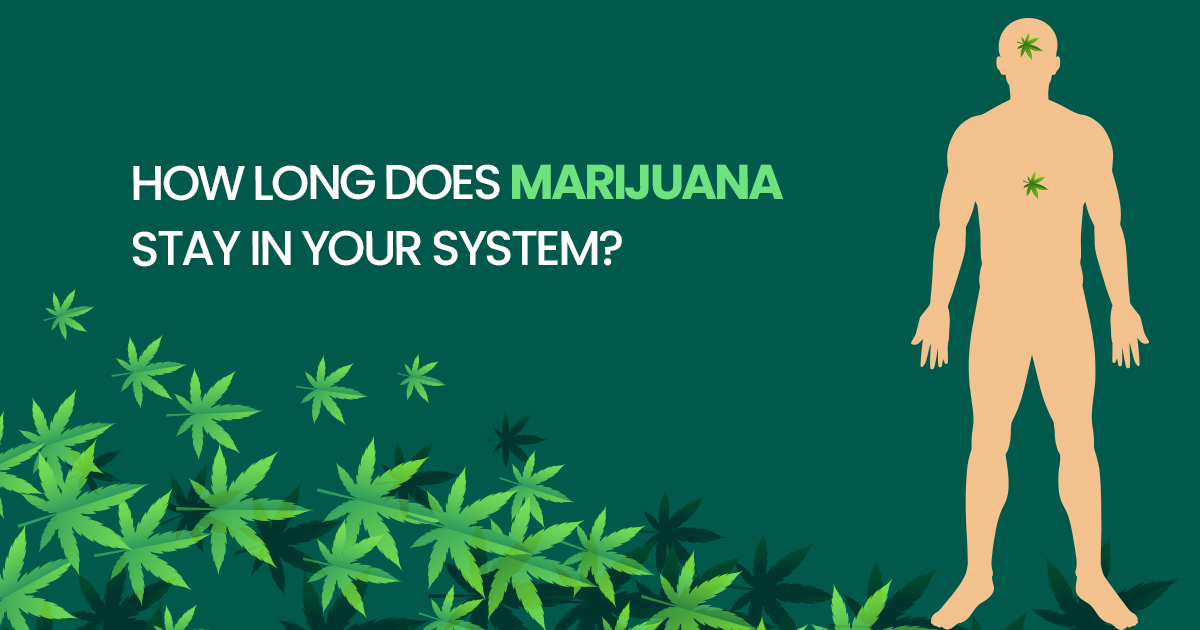The answer to the common question of, “how long does marijuana stay in your system?” depends on various factors. The dimensions of an individual body, A person’s prior drug history, diet, sleep habits, and exercise are some of the factors involved in accurately knowing how long marijuana will stay in your system and not just some average statistic.
This article will go into more depth to try to more accurately answer the question, “How long does marijuana stay in your system?”
What Factors Effect How Long Marijuana Stays in Your System?
So, how long does it stay in the body? “The effects of marijuana usually last from 1 to 3 hours, but cannabis can stay in the body for days or even weeks after use.” says the National Drug Abuse Archives. In addition, fat lipids do absorb THC and CBD. Most standard urine tests can find marijuana remnants many days later in casual users and many weeks later in the case of heavy users. It’s common for marijuana to appear in urine tests up to 30 days after use.
The specific amount of time depends on some factors, including:
Diet and Excercise
Marijuana, like any drug, is affected by what you eat and how much activity you get. A life of lethargy and low movement means that the chemicals and enzymes in marijuana will stay in your fat lipids and cell walls and take much longer to disperse.
Two things will happen if you are active and enjoy a regular exercise regimen. One, you will lessen how long marijuana stays in your system. Two, you will experience the effects of THC much quicker.
Prior Drug Use
If marijuana is a drug you are using to substitute for something you have a substance abuse issue with, you should know more than just how long marijuana stays in your system. Users of cannabis who’ve used it as an alternative to mind-altering chemical addiction found that often they would have flashbacks when high. Sometimes as long as three to five years in the future.
You can also build up a tolerance for Marijuana the more of it you smoke. The more often you use it, the less of the effects you’ll feel, causing you to have to use more of it and resulting in a longer duration of how long marijuana stays in your system.
Marijuana Withdrawal
Marijuana is a drug, and despite having no chemically addictive properties, it does have a habit-forming component. A countdown begins when the endocannabinoid receptors are activated due to THC and CBD contact. This countdown is your body getting an overload of serotonin, dopamine, and other chemicals, flooding the receptors.
Now your body tries to keep the levels you experience high with the natural production of dopamine in your system. When it can’t replicate enough, you start to experience marijuana withdrawal.
Withdrawal Effects
In first-time users, this generally dissolves after the effects of ingestion do. In casual and extreme users, the effects are more poignant. Irritability, tiredness, and hunger are the most common signs. These usually subside, although sometimes another dose is needed to satiate these modalities leading to addiction.
With more frequent users, the effects can be much more powerful. The body can begin to overproduce Inositol, which can cause sleeplessness, mood swings, and depression. This presents cannabis withdrawal in a light that is no different from any other substance withdrawal.
Marijuana in its Different Forms
The different ingestion methods of marijuana play a factor in absorption and duration of effects. From edibles to vaping, shatter to raw bud, how you ingest marijuana will help you figure out how long marijuana stays in your system in particular.
Edible Marijuana
All forms of baked goods, beverages, candies, and confections can be obtained containing CBD, THC, or being broad-spectrum, containing both. When it comes to edibles, the actual release of the marijuana components is slower. The true CBD oil that most edibles contain can be detected in standard urine tests as much as two or three weeks after ingestion.
“Shatter”
“Shatter” is an incredibly potent form of concentrated marijuana. Some batches can reach potencies above 230% compared to raw flowers. Due to its potency, shatter is a common choice for those looking to satiate a drug craving. The effects are much more short-term, some 1-3 hours. Shatter stays in your system the same amount of time as other methods, but the tar from smoking can stay in your lungs much longer.
Tinctures and Tonics
For many, smoking or pill ingestion can be triggering and off-putting, especially for those trying to kick other addictions. Taking a drop under the tongue or drinking a flavored beverage can be the preferred method of ingestion for some users.
Raw Flower
The act of smoking is most common for the direct delivery of THC and CBD to the system. It is also preferred by those trying to overcome cigarette addiction. This form of marijuana stays in the system the same amount as others and can show in urine tests as much as 3-4 weeks after ingestion.
Tar Build-Up
When asking how long marijuana stays in your system, it is important to note that the tars and toxic components built up in the lungs from smoking can take years to break down. The tar can coat your lungs and cause fibrous deposits that can take ten to fifteen years to expel and heal from.
Getting Help for Cannabis Addiction
When it comes to marijuana use, the NDCI has this to say ” the longer the duration and the greater the frequency of cannabinoid usage the greater the body storage of fat-soluble metabolites.” In other words, the more you use and more of it at each use, the longer it will remain detectable in your system.
If you or somebody you know has questions about cannabis addiction, learn more about facilities, contact a team member of Covenant Hills Treatment today by calling 844-268-8412.








